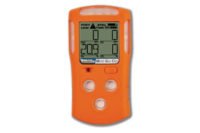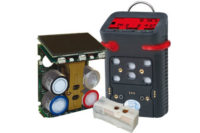Non-dispersive infrared (NDIR) sensors are increasingly being used in multi-sensor instruments to measure LEL combustible gas. But remember, no single type of sensor can detect all types of dangerous gases and vapors. Manufacturers offer different types of sensors to measure combustible gas and VOC vapors.
Non-dispersive infrared (NDIR) sensors measure gas as a function of the absorbance of infrared light. Molecules consist of atoms held together by bonds that can vibrate (stretch, bend or rotate) in three dimensions. When a chemical bond absorbs infrared radiation, the bond continues to vibrate at the same frequency but with greater amplitude after the transfer of energy. For infrared energy to be absorbed (that is, for vibrational energy to be transferred to the molecule), the frequency must match the frequency of the mode of vibration.
When infrared radiation passes through a sensing chamber that contains gas, only those wavelengths that match the vibration modes of the chemical bonds in the molecules of gas are absorbed. The rest of the light is transmitted through the chamber without hindrance. The instrument measures the amount of light that is absorbed by the molecules in the sensing chamber.
| Jump to |
| Beer-Lambert Law |
| Wavelength for measurement |
| Limitations of Wheatstone bridge |
| Advantages of NDIR LEL sensors |
| Limitations of NDIR sensors |
The Beer-Lambert Law
The strength of the NDIR sensor signal is determined by the Beer-Lambert Law, a basic law of physics. According to Beer’s Law, the strength of the signal is proportional to (1) the intensity of the beam of infrared light; (2) the specific absorbance characteristics of the molecules of gas in the optical sensing chamber; (3) the distance the light travels through the sensing chamber (the optical path length); and of course, (4) the actual concentration of the gas being measured.
Optimizing instrument performance along one parameter usually requires a tradeoff along another parameter. Using an IR source that produces a brighter beam of light increases signal strength, but takes more power. Lengthening the optical path provides greater opportunity for the molecules to absorb the light, improving the sensor’s ability to measure gases with lower relative responses, while at the same time allowing use of a lower power IR source to achieve the same strength of signal. But it means the sensor is physically larger.
Due to design considerations, NDIR sensor performance characteristics can differ significantly between manufacturers. However, all NDIR sensors share certain performance characteristics.
What is the wavelength used for measurement?
The wavelength ranges most frequently used for combustible gas measurement are near 3.33 μm (micrometers) or 3.4 μm. A filter limits the band of wavelengths used for measurement. The active detector measures the amount of infrared light absorbed at this wavelength range. A reference detector measures the amount of light at another wavelength where there is no absorbance.
Catalytic Wheatstone bridge type LEL sensors are more sensitive to small molecules like methane than to larger molecules like pentane or hexane. The opposite is true for NDIR sensors. The chemical bonds in the molecules being measured absorb the infrared light. Since larger molecules have more chemical bonds holding the atoms in the molecule together, they provide more opportunities for infrared radiation to be absorbed. NDIR sensors cannot measure a gas unless the bonds in the molecules absorb IR at the measurement wavelengths.
It is primarily the “stretch” vibrational modes of the C-H bonds in combustible gas molecules that absorb infrared light near 3.33 μm and 3.4 μm. Methane (CH4) has only four C-H bonds. Pentane (C5H12) has 12 C-H bonds. It makes sense that the relative response of the NDIR sensor to pentane is greater than the response to methane.
Any chemical groups in the molecule that depress or reduce the “stretch” vibrational mode reduce the overall absorbance of IR light at these wavelengths. For instance, ethane (C2H6) and ethene (C2H4) are very similar molecules. But ethene has two fewer hydrogens, and includes a C=C double bond that reduces the stretch vibrational mode. Although ethene is still detectable, it has a lower relative response.
Although acetylene (C2H2) has two C-H bonds, the presence of a triple bond between the two carbon atoms so reduces absorbance that it renders the molecule unmeasurable at 3.33 μm or 3.4 μm. However, the C≡C triple bond shows strong absorbance at a wavelength of 3.01 μm. Unfortunately, while acetylene absorbs strongly at 3.01 μm, most other commonly encountered combustible gases do not, making the wavelength a poor choice for general LEL measurement.
Instruments equipped with NDIR sensors for combustible gas measurement generally include a library of response curves. For methane or natural gas measurement, it is best to use the methane scale and calibrate the sensor using methane gas. For measurement of alcohols and saturated hydrocarbons (such as ethane, propane, butane, pentane, hexane, nonane, etc.), it is better to operate the instrument on the propane scale, since the relative responses of these gases and vapors are fairly similar to each other. For unsaturated gases such as ethylene or benzene, direct calibration to the gas of interest is normally the best approach.
Limitations of catalytic Wheatstone bridge type LEL sensors
Traditional combustible gas sensors detect gas by oxidizing (burning) it on an active bead that is heated to a very high temperature (550°C). The sensor can only detect gas that is able to reach and penetrate the bead. The bead is protected behind a flame arrestor. The larger the molecule, the slower it diffuses through the flame arrestor and into the active bead of the sensor. Small combustible gas molecules like hydrogen (H2), methane (CH4) and propane (C3H8) diffuse very rapidly into the sensor, and are detected quickly. Larger molecules like hexane (C6H14) or octane (C8H18) are still detected accurately, but take longer to reach the active bead, and have a much lower relative response.
Saturated hydrocarbons larger than nonane (C9H20) are unable to reach and penetrate the active bead at all in appreciable quantities. Traditional type LEL sensors should not be used to measure hydrocarbon gases larger than nonane in size. Less than 4% of the molecules in a bucket of diesel fuel are small enough to be measurable by means of a traditional LEL sensor. This is one reason why Wheatstone bridge type LEL sensors show a low response when exposed to the vapors of “heavy” fuels such as diesel, kerosene, jet fuel and heating oil.
Traditional LEL sensors need the presence of oxygen to detect gas, and are highly vulnerable to sensor poisons like volatile silicones, high concentration sulfides, hydrides like phosphine and arsine, and halogenated solvents and degreasers such as methylene chloride. Because they lose sensitivity so easily, catalytic LEL sensors need to be tested and adjusted on a regular basis.
Advantages of NDIR LEL sensors
• Intrinsically safe NDIR sensors do not need to be equipped with external flame arrestors that slow or limit the entry of large hydrocarbon molecules into the sensor.
• NDIR sensors do not require oxygen.
• NDIR sensors are not damaged by exposure to traditional LEL sensor poisons, and do not tend to lose span sensitivity in normal operation.
• NDIR sensors can be used for measurement of high concentration gas up to 100% volume.
Limitations of NDIR sensors
NDIR sensors cannot be used to measure gases that do not absorb infrared light. “Diatomic” molecules like oxygen (O2), nitrogen (N2) and hydrogen (H2) do not absorb infrared light. In applications where hydrogen may be potentially present, the instrument should be equipped with a traditional type LEL sensor, or an electrochemical sensor capable of directly measuring H2 in the desired range.
NDIR sensors can only be used for gases that absorb IR light at the wavelengths being measured. For instance, NDIR sensors that measure at 3.33 μm or 3.4 μm cannot be used to measure acetylene.
The NDIR sensor must have a strong enough response to measure the gas or gases of interest. To measure a mixture of gases including chemicals with double bonds, or aromatic VOC gases with benzene rings, talk with the manufacturer about the relative response of the sensor to these gases.



